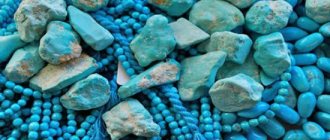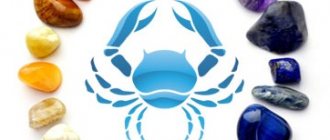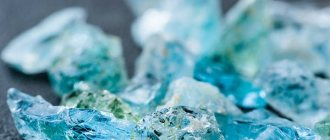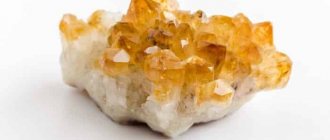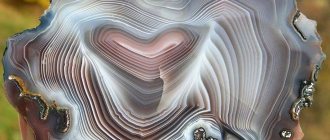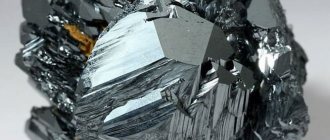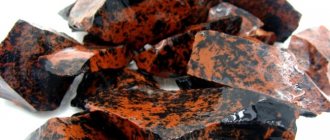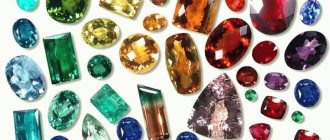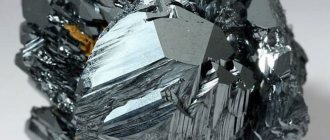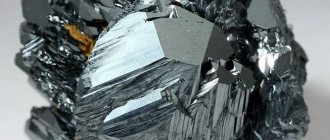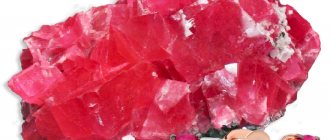/ List of stones / Properties of Blue Tourmaline
0
3724
Article rating
Blue tourmaline is a blue-green gemstone also called indigolite. In the natural environment, tourmaline occurs in the form of minerals that resemble oblong cylinders. The jewelry is quite fragile, the hardness determined by the Mohs scale is slightly more than 7 points. Tourmaline was first mentioned in history in the 5th century. A little later, this variety was brought to Europe. Europeans immediately fell in love with the beautiful shade and they began to use this mineral for insertion into precious jewelry. In Russia, they learned about the gem in the second half of the 19th century, when deposits of this stone were found in the Urals, where they later began to mine minerals of a regular cylindrical shape of a stunning color.
Properties of blue tourmaline
Tourmaline comes in a range of colors and can be black, red, pink or light. Indigolite can have a blue, blue or green tint.
It happens that a gem does not have a rich shade or contains several colors, in which case the gem is exposed to a laser. After this procedure, the gems acquire a more saturated color or brighter color. The use of stone for jewelry is not accidental; the mineral harmonizes well with noble metals, best of all in products made of gold and silver. Silver emphasizes the magical beauty of tourmaline; in combination with gold, the stone shines even more. Tourmaline is a precious mineral, so its price fluctuates around $80 per carat. To fully understand what the blue tourmaline mineral looks like, you can take a closer look at the photo or video.
Rare blue Paraiba tourmaline
Paraiba is the rarest and most expensive variety of tourmaline.
Some examples easily compete in price with large diamonds of the highest characteristics. Paraiba tourmaline has a vibrant color palette, ranging from sky blue and turquoise tones to rich light green tones. Paraiba crystals are recognized as the benchmark examples of neon blue color in the gemstone market. The presence of copper and manganese impurities in the minerals determines the unique color of these tourmalines. It should be noted that all blue and blue tourmalines cannot be classified as Paraiba. It is the presence of copper ions that is the main factor that allows blue tourmaline to be called Paraiba tourmaline. Up to 80% of tourmalines of various types are mined in Brazil. This country also became the birthplace of the unique Paraiba tourmaline, which was named after the Brazilian state of Paraiba. It was in this state that the first specimens of Paraiba were discovered in 1987. The unique sky blue tourmalines were discovered by local prospector Heitor Dimas Barbosa, who spent several years searching for these minerals. The stones of a hitherto unprecedented color he found were immediately snapped up by traders, who spread news of a new variety of tourmalines throughout the world.
Almost until the end of the twentieth century, everyone was confident in the absolute uniqueness of the Brazilian deposit of this variety of tourmaline. At the end of 2001, experts were surprised to discover neon blue tourmalines from Nigeria on the jewelry market, found in the Eduku deposit. Analysis of the chemical composition of the stones showed the presence of impurities of copper and manganese, which determine the color tone. African samples tend to be less saturated than Brazilian Paraiba.
Then, in 2003, in Mozambique, in the Alto Ligonya region, analogues of Brazilian tourmalines were found at the Muyane mine. These stones also contain copper, slightly less manganese, as well as traces of lead, beryllium, gallium and bismuth. Today, most copper-containing tourmalines come to the market from Mozambique. There are very few Brazilian stones on the market and, as a rule, they do not exceed 2-3 carats. It is important to note that the cost of Brazilian stones is several times higher than the cost of African ones. African stones can reach tens of carats.
Description and history of the stone
The blue color of the stone is due to the admixture of iron compounds. In nature, blue tourmaline occurs in the form of rectangular crystals with clearly visible vertical shading.
It is mined in Madagascar, the USA, Namibia, and Russia. Blue tourmaline is even rarer and is called Paraiba. Previously, it was mined on the island of Sri Lanka, now the main supplier of the mineral is Brazil.
The first chronicle mentions of the gem date back to the fifth century AD.
The stone was discovered in India or Persia; other countries did not know about it for a long time. It appeared in Europe after the 15th century. In Russia it began to be mined after the 18th century. The first deposit was discovered in the Urals. Because of its blue color, the gem began to be called indigolite.
Paraiba from Brazil or Mozambique?
Despite the large difference in price, Paraiba tourmalines from Mozambique of high jewelry quality can be as beautiful as Brazilian standard stones. There is also a misconception that Paraiba from Mozambique cannot be called Paraiba, unlike the Brazilian one, so it is important to note that blue African tourmalines containing copper ions are officially recognized by the world gemological community as Paraiba tourmaline along with samples from Brazil. Expert opinions from the world's most authoritative laboratories on stones whose blue color is due to copper always indicate that this tourmaline belongs to the “Paraiba Tourmaline” type, regardless of the region of its origin.
How to recognize a fake
People have long been able to grow this gem in laboratory conditions. Due to the complexity and high cost of the process, synthetic tourmaline is created only for technical purposes. Most often, glass is passed off as a natural gem.
There are several signs that allow you to assess the authenticity of tourmaline:
- A gem of natural origin cannot be scratched.
- The natural mineral is electrified. After heating and rubbing the stone, hair and pieces of paper stick to it.
- It has inhomogeneous color, pleochroism and birefringence.
An artificial gem is devoid of magical and healing properties.
Refinement of Paraiba tourmaline
Most Paraiba tourmalines are refined through heat treatment to achieve a better color range. The natural coloration of Mozambican specimens usually has a palette of purple, pinkish, green and yellowish-green shades. After heat treatment, the primary tones disappear, and the crystals acquire a noble neon blue color, the color change is stable and unchanged in the future. Brazilian Paraiba specimens initially have a sky-blue tonality. Refinement eliminates violet shades and improves the saturation of the blue range. It is important to note that heat treatment of Paraiba tourmaline crystals is a common practice, and due to the great rarity of this gem, heat treatment of top-end specimens has virtually no effect on the cost.
Paraiba tourmalines of medium commercial quality with a lot of inclusions and cracks use various polymers to fill the cracks, thereby improving the clarity of the stone. Stones of this quality can often be cut into cabochons. Of course, heat treatment and artificial improvement of purity significantly reduce the cost of stones. You should carefully study the expert opinion on the purchased tourmaline issued by the gemological laboratory.
Properties
Complex boron-containing silicate of magnesium and aluminum.
An oblique view of the whole crystal structure of tourmaline
View of a tourmaline structure unit along the crystal axis
Axis view of three columns of tourmaline units forming a bundle
Structure of a tourmaline crystal as viewed along the c-axis of the crystal
Physico-chemical
- The crystals are hard but brittle.
- Tourmaline that changes color when daylight changes to artificial light is called chameleonite.
- The crystals have a well-defined zonal growth pattern. The color change occurs not only along the main axis of the crystal, but also in the transverse direction.
- Dichroic; This is especially evident in the “head of a Negro (Moor, Turk)” variety.
- It has a piezoelectric effect (when pressed or mechanically applied, an electric charge appears on the surface of the crystal).
- Has pyroelectric properties.
- Mineral crystals are sensitive to temperature increases. If you electrify a crystal, its temperature changes. Tourmaline directly converts thermal energy into electrical energy.
- The red color of the gems is stable when heated.
- Red tourmaline has a strong pleochroism - from dark red to yellow to scarlet.
Tourmaline pleochroism
Some crystals have a sharply defined thin strip of light, if possible oriented along the long axis of the polished stone. This is a cat's eye, highly prized by mineral connoisseurs.
Lithotherapist's book
First, visit a doctor, find out the diagnosis, buy medicine... And only then, if you want, start treatment with stones.
- Lithotherapists in the USA use sherls to get rid of negative energy and relieve pain. To do this, the “pendulum” with the crystal is rotated counterclockwise over the sore spot.
- Verdelite is used in lithotherapy as a strengthening nervous system and rejuvenating agent. Helps with heart and kidney diseases.
- Indigolite harmonizes the hormonal system and stimulates metabolic processes in the body.
- Rubellites normalize blood composition and improve heart function.
- Dravit is used for insomnia, stress, and depression.
Important : thyroid disease, fever (high temperature), pacemakers, pregnancy - the use of tourmaline is not recommended for these conditions.
Colorful magic
Each variety has its own magic.
| Variety | Magic properties |
| Indigolite | Used by magicians and astrologers to connect with the energy of the Cosmos |
| Achroite | Clears the mind, creates a balance of physical and spiritual forces |
| Rubellite | Harmonizes the heart chakra |
| Dravit | Stimulates Manipura Chakra |
| Verdelite | Restores the integrity of the aura. |
| Cherry red tourmaline | Associated with tantric energies |
- Rubellites “manage” love and similar emotions.
- Indigolite is a good talisman for students.
- Verdelites are useful for creative people.
- Achroites are good for yoga fans. These stones are suitable for meditation.
Expert opinion
Semenishcheva Polina
Specialist in mineralogy. Graduated from St. Petersburg Mining University.
Each type of gem will protect the owner from negative energy.
Paraiba tourmaline cost
Paraiba tourmalines from the Brazilian deposit are very rare lots on the world jewelry market, like Burmese rubies. It is geographic origin that is the main pricing factor here. Stones supplied from Mozambique have a lower cost compared to Brazilian ones. High-quality Brazilian tourmaline may have a much smaller mass than Mozambican tourmaline, but have several times the price per 1 carat. The price of the purest and highest quality blue Paraiba is comparable to the price of good diamonds and reaches $20-30,000 per carat. The price for Paraiba from Mozambique, depending on the purity and color saturation, is in the range of $1,500-9,000 per carat.
In recent years, the price of Paraiba tourmalines on the market has been growing rapidly, sometimes by 20-30% per year. Paraiba often outperforms unheated sapphires and Colombian emeralds in cost per carat, placing these minerals in the highest price category. The price of tourmalines per carat often exceeds several tens of thousands of dollars. Today this stone tops the list of the most attractive gemstones for investment.
Legendary tourmalines
This gem was considered the best gift for royalty. The most legendary gem was considered to be a specimen in the form of a bunch of grapes - “Caesar's Ruby”. According to legend, it was given to Caesar by Cleopatra. After some time, traces of the jewelry were lost. She wandered from country to country for a long time and in the 18th century she came to Gustav VIII, who presented her as a gift to Catherine II.
Initially, this gem was considered a ruby.
Only in the 20th century did jewelers determine that it was Burmese pink tourmaline. Today the semi-precious stone is the property of the Diamond Fund of Russia.
The second famous artifact is the 500-fold tourmaline in the crown of Anna Ioannovna.
Neon glow of Paraiba tourmaline
Tourmalines, like emeralds, belong to the second group of purity stones. This suggests that a larger number of inclusions is permissible for them, and this has less impact on their cost. Paraiba tourmalines are characterized by white or translucent gas-liquid veils. You should not be afraid of them, because these veils, thanks to the optical effect of iridescence (iridescent color radiance in bright light), enhance the effect of neon blue glow and can even visually increase color saturation. This effect is more pronounced on stones with such inclusions than on pure samples. Thus, Paraiba tourmalines with a small number of inclusions can be more affordable and, at the same time, not inferior in the strength of the effect they produce on others.
Field
Until recently, Paraiba was mined only in Brazil - first in the state of the same name, and later in Rio Grande do Norte. Today, the South American state provides the jewelry market with Paraiba gems in small quantities, since their reserves have almost dried up. Since 2000 stones are mined in Africa: in Nigeria and Madagascar, and since 2005, Mozambique has become the world's largest supplier of Paraiba tourmalines.
Mozambican crystals are in many ways inferior to Brazilian ones: they do not have the required color depth and are not so rare, so their cost is 5–10 times lower than gems of Brazilian origin.
Would you like to buy Paraiba tourmaline in Moscow?
In our catalog you will always find excellent examples of neon blue Paraiba tourmalines, you will be able to compare prices and understand the approximate budget for a future purchase.
To see this jewelry stone and products with it in person, we invite you to visit our boutique in the center of Moscow.
In addition to the stones in stock, our team is happy to offer a custom order service. Based on your requirements and budget, we will select the best example of rubellite for you.
You can also order the manufacture of jewelry with this stone. Today we have one of the best full-cycle jewelry workshops in Moscow.
Interesting facts about Paraiba tourmaline
- A mermaid-shaped brooch from the Arunashi brand, made of white gold, is considered a true work of art. The brooch was decorated with 2.2 carats of Paraiba and 5.35 carats of exquisite diamonds. The ring from the Sutra brand, decorated with six diamonds and seven pear-shaped tourmalines with a total weight of 8 carats, is distinguished by real nobility. This jewelry masterpiece is valued at $130,000.
- The amazing “Baroque” necklace is considered an outstanding work by the famous designer Giampiero Bodino. The jewelry is made of white gold and features 326 carats of African Paraiba stones surrounded by numerous diamonds.
- A golden ring from Dior with a magnificent large Paraiba crystal framed with spessartines, sapphires, emeralds and diamonds is called a flight of fancy.
Crystal magic
The mineral has not only healing, but also magical properties that manifest themselves when interacting with a person, and depend largely on his character.
The magical properties of the stone are the protection of its owner from any negative influence. It is believed that the amulet protects against spirits, otherworldly creatures and simply evil people.
The gem gives a person confidence and determination, pushes him to reach his goal, regardless of the circumstances. In ancient India, it was customary to give a talisman to men, as it supports their reproductive function and prevents disorders in the reproductive system.
Gold ring with tourmaline and cubic zirconia (go to the SUNLIGHT catalogue)
The crystal can reveal deceitful people. It was often used in rituals, including church ones. Even today you can see tourmaline on church objects and clothing of high clergy.
Watermelon stones will help develop creative character traits. In addition, the mineral will suggest the right solution in difficult life situations and will bring good luck and joy.
Since the talisman helps to understand oneself and lifts the veil of the subconscious, it is often used during meditation. In some cases, the stone can become a symbol of love, as it helps to improve relationships and ignites passion.
When choosing a talisman, you need to remember that the magical and healing effects of the stone cannot be separated. Tourmaline products can only be worn by those who are suitable for this mineral according to medical criteria. Then this magic stone can really change a person’s life for the better. And if the owner of the talisman has medical contraindications, then instead of magical help he will only cause harm to health.
